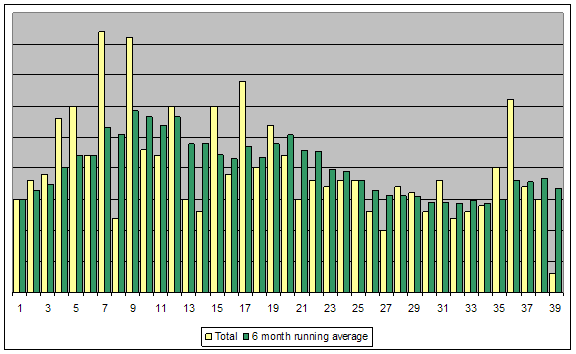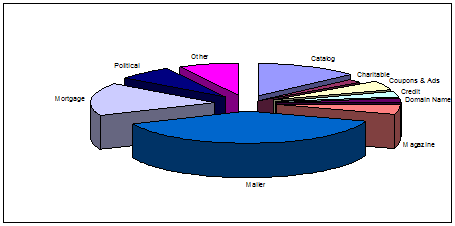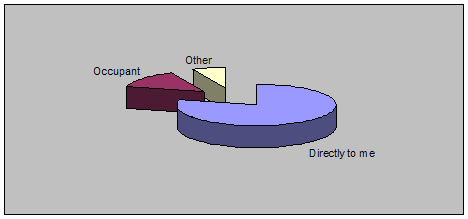Get Results
What I did
When I started three and a half years ago (as of 3/06), I had already been on the Direct Marketing Associations do-not-send list for over three years. By my own estimates, and to the credit of the DMA and those direct marketers that responsibly use their list, signing up on the do-not-mail list cut the volume of my direct mail about in half.
Since I started this quest, I have responded to every piece of direct mail I have gotten with some kind of attempt to stop receiving it. My general approach for a specific sender has been as follows
1st mail piece: I send them a postcard, call them, or email them asking them to take me off of their mailing list.
2nd mail piece: I send them a letter explaining the laws on direct mail and threatening to file a BBB complaint and a USPS prohibitory order if they continue to send me direct mail.
3rd mail piece: I file a prohibitory order and a BBB complaint. I send them a letter telling them that I have filed both of these and letting them know the consequences if they continue to send me direct mail.
4th mail piece: I file prohibitory order violations with the USPS.
Results
Here is the overall volume by month since I started tracking my direct mail.
What this shows is somewhat alarming:
- In the beginning of my experiment, despite my efforts, the volume of direct mail started going up!
- It took a very long time and an enormous amount of effort before the total direct mail started going down.
- Despite all of my effort, I am not all that much better than when I started, and I can’t get the volume of direct mail below a certain volume.
Here are some quick statistics on what I received.
Breakdown by type:
Breakdown by addressed to:
The single most abusive segment of direct mail is the mortgage industry. Making up an astonishing 17 percent of the total direct mail volume (one of every six pieces received), this category proved to be the most difficult segment to effect. Second to mortgage offers were catalogs. Almost every retailer I purchased from online put me on their catalog mailing list, despite in many cases my specifically asking them not to. Many also started sending me catalogs from related retailers. Some retailers told me that whenever I ordered something I was automatically added to their catalog mailing list, despite my asking when I ordered not to be put on their list, and having previously asked as well. However, unlike mortgage brokers, most catalog retailers were very responsive and the number of catalogs over time dropped significantly.
My results show that you can have some effect, given enough time and effort. My results also show that there is no possible way to stop all direct mail. The current legal framework and the way the USPS operates do not allow for this.
One of my goals was to become a HUGE pain in the ass to everyone that sent me direct mail. In this I definitely succeeded. I figured to waste their time since they were wasting mine.
In Depth Results and Analysis
I like to divide up direct mail into three classes: normal direct mail, political direct mail, and saturation mailings.
Normal direct mail
Normal direct mail is mail that comes from a company with your name and address on it. The company probably rented a list from a mailing list broker or used a mass mailing service, or had you on their own internal mailing list because you were a customer. This type of mail has to be dealt with on a case-by-case basis.
Political direct mail
Political direct mail originates from voter registration lists, which are made available to any political candidate or organization. I have gotten as many as fifteen pieces of political mail in just a few weeks before an election cycle. Other than canceling your voter registration, there is no easy way to stop this kind of mail because candidates and political organizations are given access to your personal information by law. The law only allows for suppression of personal information by court order if you will be endangered by having your personal information released.
I have found two solutions to this problem:
- s Don’t register as an independent. Both major parties will try to sway you with lots of literature. This will cut down on much of your political junk mail.
- Un-register after every election, and re-register just before (typically two weeks is the deadline) each election.
Contact your county registrar of voters to get an un-registration form.
Saturation mailings
Saturation mailings are mailings that are sent to every address in an area. They are typically addressed to “Resident,” “Occupant,” “Theatre Lover, etc. This is one area that is very difficult to have an effect because of the way saturation mailings are done. Here is a great write-up on the Postal Service’s role in these types of mailings.
I wrote to the US Postal Service asking them to not sell or give my personal information away to anyone. They responded back by saying that they never sell or give my name or address to anyone. Unfortunately, this is not true.
The Postal Service gives special low rates to companies that sent the same mail to every address on a postal route or in a given area. In order to send mail to every address in an area, they must have every address. In order to get their lists complete and up-to-date, they give a list that must be at least 90% complete of all the addresses in an area to the Postal Service, and the Postal Service will fill in the missing addresses to make the list 100% complete. This type of mailing is called a saturation mailing because of how it is done. Often times, as with other mail, the company or organization that the mail is sent on the behalf of (i.e. the company on the return address), is not the company doing the mailing. This can make it hard to find out who to contact to get off of the list.
I have repeatedly asked mailing houses to remove me from their lists, and they do, but my name gets put right back on the list as soon as they “complete” it with the Postal Service again.
It is well understood that the Postal Service sells the information that it gets from permanent address change forms to outside organizations. If you file a temporary change of address form, your information does not get sold. It is not clear if this information contributes to the saturation mailing problem.
One idea I am currently trying is to file a prohibitory order against companies that repeatedly send me such saturation mailings (i.e. the company the mail is being sent for, the company on the return address). This will force the Postal Service to take action against a company that the Postal Service is requiring to send to 100% of the addresses, including mine. I am interested to see what happens. So far it seems to have worked in some instances, after filing many prohibitory order violations.
What needs to happen here is that the Postal Services practice of giving away addresses needs to be challenged in court.
The Laws on Direct Mail
Your power to tell companies to stop sending you direct mail stems from the United States code, title 39, section 3008. In summary, it says that you can ask the Post Office to demand that anyone refrain from sending you anything that you consider to be erotically arousing. The U.S. Supreme Court Appeal 397 U. S. 728 established that what is considered erotically arousing is at the sole discretion of the recipient of the mail. You can find an excellentbreakdown of the legalities surrounding this at Junkbusters.
You can enforce this law by filing a prohibitory order with the US Postal Service. This is also known as form 1500. I recommend sending it directly to the prohibitory order processing center address listed on the form rather than sending it or taking it to your local Post Office. Oftentimes, local postal employees don’t know anything about this form and will probably challenge your determination that a Catalog from Dell is erotically arousing.
Here is an example of the prohibitory order & process:
A response to the prohibitory order from the Postal Service
A prohibitory order violation letter
A response to the prohibitory order violation from the Postal Service
The problem with this legal remedy is that the Postal Service is not obligated to take action against anyone you file a prohibitory order against. Whether to refer violators to the Attorney General is completely at the discretion of the Postal Service.
On more than a few occasions I had to repeatedly send letters to the Postal Service asking them what was happening with prohibitory orders I had filed. While they responded the first few times, they have stopped responding to such letters from me.
Unfortunately, in order for a prohibitory order to be filed, the original mail piece has to have the senders return address on it. Many of the shadier direct marketers don’t have return addresses on their mail pieces. They seem to be aware of this loophole.
The basis for the current lack of legal rights over your mailbox is the fact that the law says that your mailbox is the property of the Postal Service. It may be on your property, but it isn’t your property.


